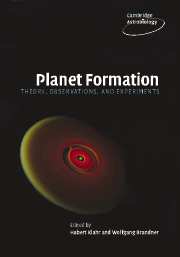Book contents
- Frontmatter
- Contents
- Preface
- Acknowledgments
- 1 Historical notes on planet formation
- 2 The Formation and Evolution of Planetary Systems: placing our Solar System in context
- 3 Destruction of protoplanetary disks by photoevaporation
- 4 Turbulence in protoplanetary accretion disks: driving mechanisms and role in planet formation
- 5 The origin of solids in the early Solar System
- 6 Experiments on planetesimal formation
- 7 Dust coagulation in protoplanetary disks
- 8 The accretion of giant planet cores
- 9 Planetary transits: a first direct vision of extrasolar planets
- 10 The core accretion–gas capture model for gas-giant planet formation
- 11 Properties of exoplanets: a Doppler study of 1330 stars
- 12 Giant-planet formation: theories meet observations
- 13 From hot Jupiters to hot Neptunes … and below
- 14 Disk–planet interaction and migration
- 15 The brown dwarf–planet relation
- 16 Exoplanet detection techniques – from astronomy to astrobiology
- 17 Overview and prospective in theory and observation of planet formation
- References
- Index
5 - The origin of solids in the early Solar System
Published online by Cambridge University Press: 14 September 2009
- Frontmatter
- Contents
- Preface
- Acknowledgments
- 1 Historical notes on planet formation
- 2 The Formation and Evolution of Planetary Systems: placing our Solar System in context
- 3 Destruction of protoplanetary disks by photoevaporation
- 4 Turbulence in protoplanetary accretion disks: driving mechanisms and role in planet formation
- 5 The origin of solids in the early Solar System
- 6 Experiments on planetesimal formation
- 7 Dust coagulation in protoplanetary disks
- 8 The accretion of giant planet cores
- 9 Planetary transits: a first direct vision of extrasolar planets
- 10 The core accretion–gas capture model for gas-giant planet formation
- 11 Properties of exoplanets: a Doppler study of 1330 stars
- 12 Giant-planet formation: theories meet observations
- 13 From hot Jupiters to hot Neptunes … and below
- 14 Disk–planet interaction and migration
- 15 The brown dwarf–planet relation
- 16 Exoplanet detection techniques – from astronomy to astrobiology
- 17 Overview and prospective in theory and observation of planet formation
- References
- Index
Summary
Introduction: geoscience meets astronomy
Much of our knowledge about the formation of planets in the Solar System and in particular concepts and ideas about the origin of the Earth are derived from studies of extraterrestrial matter. Meteorites (Sears, 2004; Lauretta et al., 2006; Krot et al., 2006) were available for laboratory investigations long before space probes were sent out for in situ investigations of planetary surfaces, or Moon rocks were brought back to Earth. Meteorite studies provided such important parameters as the age of the Earth and the time of formation of the first solids in the Solar System (Chen and Wasserburg, 1981; Allegre et al., 1995; Amelin et al., 2002), as well as the average abundances of the elements in the Solar System (Anders and Grevesse, 1989; Palme and Jones, 2004). Traditionally, the study of rocky material requires techniques that fundamentally differ from astronomical techniques. While electromagnetic radiation from stars is analyzed by spectroscopy, the solid samples of aggregated cosmic dust and rocky matter from planetary surfaces require the use of laboratory instruments that allow the determination of their chemical and isotopic composition. Planetary surface materials are present in polymineralic assemblages. Formation conditions and thermal stability of individual minerals provide important boundary conditions for the genesis and history of the analyzed materials. Such studies require a thorough mineralogical background. The abundances and properties of the rock-forming elements, the focus of geo- and cosmochemical research, are, however, not necessarily of major concern to astrophysicists.
- Type
- Chapter
- Information
- Planet FormationTheory, Observations, and Experiments, pp. 64 - 89Publisher: Cambridge University PressPrint publication year: 2006
- 12
- Cited by

